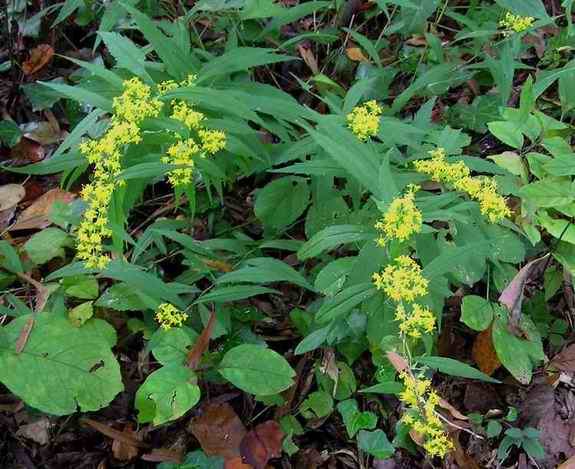|
Return to Hiker's Notebook Home Page
Common Name: Goldenrod, Aaron's rod, Goldruthe, Gonea tea, Solidage, Blue Mountain Tea, Verge d'Or, Woundweed, Woundwort - The golden flowers generally grow along the stem like a golden rod.
Scientific Name: Solidago spp. - The generic name is from the Latin root solidare meaning to strengthen; this is in reference to the alleged healing powers of the plant, which serve to strengthen the body.
Goldenrod is a ubiquitous flower that hybridizes readily to the extent that there is no general agreement as to the number of species and subspecies, likely over a hundred. The characteristic golden flowers are composite, consisting of pistillate ray flowers and perfect disc flowers (perfect means they are monoclinous, having the stamen and the pistil on the same flower). The leaves are simple and alternate and range from very narrow with no teeth to large, egg-shaped and serrated. The names of the different species in general provide a descriptive mnemonic: Sweet goldenrod (S. odora) gives off an anise scent; Rough-stemmed goldenrod (S. rugosa) has a rough stem; Showy goldenrod (S. speciosa) has dense, pyramid-shaped showy flower clusters: Tall goldenrod (S. altissima) is two to seven feet tall.
Goldenrod is often maligned as the source of hay fever since it is the most obvious inflorescence of autumn when the malady is manifest. Ragweed (Ambrosia spp) is the actual cause as it produces prodigious clouds of dust-like pollen that bombards sensitive nasal tissue to trigger the allergic reaction. Billions of pollen grains are necessary for successful propagation of ragweed as it employs the mercurial wind-borne means of transmission. The pollen of the goldenrods is relatively heavy and sticky, as it has evolved to be carried away by insect pollinators that are attracted to its bright flowers.
Thomas Edison founded the Edison Botanic Research Corporation in collaboration with Henry Ford and Henry Firestone in Fort Myers, Florida to seek a domestic source of natural rubber. After testing more than 17,000 plants between 1927 and 1929, goldenrod was selected as the best candidate; crossbreeding eventually resulted in a twelve foot tall plant that was about twelve percent rubber. Ford reportedly gave Edison a Model T with tires made from goldenrod rubber. The project was continued by the USDA after Edison's death and was only terminated with the development of synthetic rubber during the Second World War.
Goldenrod has long been considered a medicinal plant; the names Woundwort and Woundweed attest to its purported vulnerary properties. It has traditionally been used in the treatment of kidney related problems, notably infections of the urinary tract. Its healing properties are attributed to a compound called quercetin which has diuretic and carminative properties.
Native Americans used several types of goldenrod in their medical ministrations. The Chippewa knew it as gizisomukiki, or sun medicine, the plant being boiled in water to produce syrup for treating colds. A poultice made from the leaves was placed in the mouth for a toothache; one made from the roots was used to soothe burns and boils. The Cherokee made a tea that was applied to bruises; a boiled down salve was applied to insect stings. Among its many other uses was in the healing the saddle sores of horses.
Goldenrod was employed by early settlers according to the traditions learned from their Indian predecessors. The flowers were picked and steeped in water to produce a yellow dye. Goldenrod tea was prescribed as a palliative for melancholy. The tea became so widely used that subsequent to the dispatch of English tea to the waters of Boston Harbor known euphemistically as the Boston Tea Party it became known as "Liberty Tea," its use a matter of patriotism for the nascent new republic.
There are many legends associated with Goldenrod, a reflection of its widespread adaptation to a multiplicity of environments and its ostentatious appearance. Wearing a sprig of the flower was thought to ensure that one's future love would be made manifest on the following day. A refulgence of goldenrod growing next to the door of a cottage was considered a talisman to mark the arrival of good fortune. A patch of goldenrod happened across in the woods marked the site of an underground spring. A sprig of goldenrod carried about was thought to indicate the presence of treasure by nodding in that direction. A baby washed in a bath prepared with goldenrod leaves would grow up with a sunny disposition and a good sense of humor. |
